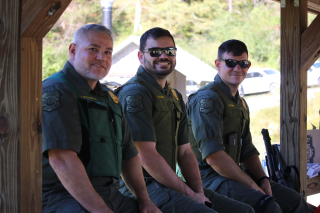Interagency approach proves successful for Kentucky wildfire prevention

KENTUCKY—After decades of challenging fire seasons, the Daniel Boone National Forest in eastern Kentucky is beginning to see a clear decline in both wildfire incidents and the number of acres impacted by wildfire each year.
Much of this decline can be attributed to the Daniel Boone National Forest Law Enforcement and Investigations team’s proactive, interagency approach to reducing human-caused wildfire.
Over 98% of wildfires in Kentucky are human-caused and nearly 60% can be directly attributed to arson. Historically, attempts to prosecute arsonists have been unsuccessful due to the inexperience of investigating officers and the lack of necessary supporting evidence.
“Basically, anybody that fought fire in the ‘90s knows where [the Daniel Boone National Forest] is because everybody spent Thanksgiving in southeastern Kentucky on arson fires,” said former Daniel Boone National Forest Patrol Captain Kim Kipp. “After 2016, when there were bad wildfires across the state, we knew that we needed to get everyone on the same page to get a handle on the problem.”
In 2016, the forest law enforcement team began conducting interagency fire investigation training with the Kentucky Division of Forestry and the Kentucky Department of Fish and Wildlife Resources. The training continues to this day and has produced a skilled law enforcement team. This team now proactively carries out community fire prevention education and effectively investigates wildfire incidents on state, federal and private lands.
The interagency training was foundational for the forest law enforcement team and special agents to provide wildfire investigation education. By growing solid working relationships with the Assistant U.S. Attorney's Office and the federal court system, the forest law enforcement team has ensured this training continues to equip investigators to provide appropriate documentation for prosecutable cases.

Forest law enforcement officers and special agents have also spent considerable time building relationships in local communities so they are not only a known, respected presence but also a resource for fire prevention. Through their continued presence, they have helped communities connect to and be good stewards of the forest.
Through their training efforts, the forest law enforcement team has also helped spread that knowledge to other law enforcement agencies that conduct investigations and community policing on the state and private lands adjacent to the forest. This cohesive community-focused approach has reduced wildfire risk to the forest and its neighbors.
“We set out to stop fires before they start,” said Kipp, who retired in 2023 after a 25-year career in law enforcement. “We know now that successful prosecutions may be a deterrent, but community education has the longest lasting impact. By attending events and leading programs, we invite our communities to join us in preventing wildfires. Our officers are there as part of the community, to protect the community.”
Now, after eight years of using a focused interagency approach, Daniel Boone National Forest law enforcement officers serve as trusted resources for incident reports and are supported in their wildfire investigations in communities where they were previously opposed. As communities continue to engage with law enforcement and take a more active role in wildfire prevention, human-caused wildfires continue to decline, are being successfully prosecuted in court and restitution funds are returning to impacted areas.
